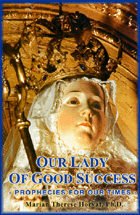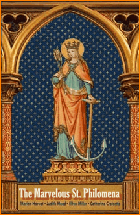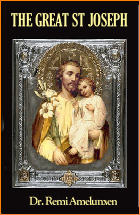Stories & Legends
 |
 |
 |
 |
 |
 |
 |
The Providential Three Windows
My mother loved to shop in rural antique stores. On one of her forages she saw a picture frame that impressed her. She admired the simplicity and large size of the frame and purchased it for that reason, not for the picture displayed in it, a country scene of some sort. She wanted the frame to make a collage of family pictures. This she did and the collage hung in their home in Mississippi for many years.
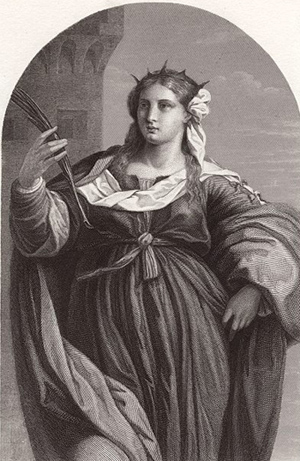 My father and mother were both converted to the Catholic Faith some 15 years after my own conversion. That is another story. The point is that, after their holy deaths, I inherited, as their only child, the collage of pictures. My wife had always admired the collage and frame, but wanted to remove some of the pictures and add those of our own. So this was one of the items we brought to our home in Baton Rouge.
My father and mother were both converted to the Catholic Faith some 15 years after my own conversion. That is another story. The point is that, after their holy deaths, I inherited, as their only child, the collage of pictures. My wife had always admired the collage and frame, but wanted to remove some of the pictures and add those of our own. So this was one of the items we brought to our home in Baton Rouge.
When we got around to working on the picture, in the process of removing the rear access panel and fillers, we discovered this sepia type picture of what we thought was “a beautiful pagan Roman lady.“ The picture was used as filler in the frame. We were so attracted to the beautiful Lady that we decided to display her in the frame and hang her in the living room instead of the den, where we intended to hand the family picture collage. The frame and picture is approximately 2 ft by 5 ft in size.
Our home is a split level structure and living room has a cathedral ceiling with three large exposed beams supporting the roof. We hung the picture of the beautiful lady on the wall opposite, facing the three large bay windows that face the front. She hung there for several months before the next event in my story.
One day my oldest son and family came for a visit. We naturally gravitated to the living room and I introduced him to our beautiful pagan Lady. He inquired, “Don't you know who she is?” I answered, “No, do you?”
“Yes,” he replied, “that is St. Barbara.” And he pointed out the palms she was holding, denoting her martyrdom, and also the tower with the “three windows that led to her death.” My son knew the whole story and told it to us:
St. Barbara was from Heliopolis of Phoenicia and lived during the reign of Maximian in the third century. The daughter of a wealthy, pagan idolater named Dioscorus, she was brought up in heathen polytheism.
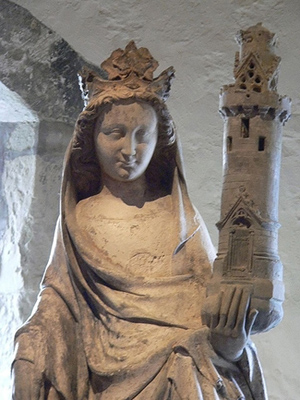 Highly intelligent and extremely beautiful, St. Barbara became interested in the Catholic Faith. Her pagan father ordered that she should live her life imprisoned in the tower because he feared the influence of Christianity on her. Vowing to protect her from the outside world, he forbade her association with friends and St. Barbara only came in contact with teachers and servants who had been carefully instructed that she be taught how to worship the pagan gods.
Highly intelligent and extremely beautiful, St. Barbara became interested in the Catholic Faith. Her pagan father ordered that she should live her life imprisoned in the tower because he feared the influence of Christianity on her. Vowing to protect her from the outside world, he forbade her association with friends and St. Barbara only came in contact with teachers and servants who had been carefully instructed that she be taught how to worship the pagan gods.
Nonetheless, she was visited by a doctor who was also a priest, and through him, she learned the Faith and was baptized. One day, as her father was leaving for a business trip, he ordered a bathhouse be built for St. Barbara. He gave specific instructions for the design of the building, commanding the workers to install only two windows. During her father’s absence she instructed the workmen to install three windows to symbolize the Holy Trinity.
When Dioscorus returned, he was enraged at the change and infuriated with St. Barbara when she confessed that she was a Christian. He took her before the prefect of the province, who decreed she be tortured. Still she would not give up her beliefs. Eventually, it was Dioscorus himself, infuriated at the vain attempts to kill his daughter, who grabbed her beautiful long hair and beheaded her. At that moment bright flames flew out of her body. A moment later, her father was struck by lightning and killed instantly.
It is because of this legend of Saint Barbara that she came to be known as St. Barbara, the patron saint of danger from thunderstorms, lightning, fires and sudden death. She is also the Patron Saint of firefighters, sailors, artillerymen and anyone who is in danger of sudden death.
Now the highlight of this story is that, after my conversion, my wife and I designed and built our current house. I drew the house plans myself and when we planned the living room, the three beams and the three windows that I mentioned above were conceived with the express intention to honor the Holy Trinity!
All who hear the story marvel at how this picture of St. Barbara, who had changed a design of her pagan father to a three window design in honor of the Holy Trinity, found her way here facing our three windows before we even knew who she was.
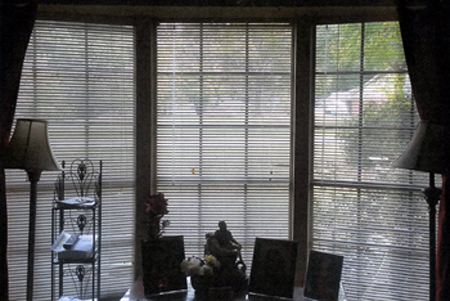



The sepia 'pagan lady' is St. Barbara
When we got around to working on the picture, in the process of removing the rear access panel and fillers, we discovered this sepia type picture of what we thought was “a beautiful pagan Roman lady.“ The picture was used as filler in the frame. We were so attracted to the beautiful Lady that we decided to display her in the frame and hang her in the living room instead of the den, where we intended to hand the family picture collage. The frame and picture is approximately 2 ft by 5 ft in size.
Our home is a split level structure and living room has a cathedral ceiling with three large exposed beams supporting the roof. We hung the picture of the beautiful lady on the wall opposite, facing the three large bay windows that face the front. She hung there for several months before the next event in my story.
One day my oldest son and family came for a visit. We naturally gravitated to the living room and I introduced him to our beautiful pagan Lady. He inquired, “Don't you know who she is?” I answered, “No, do you?”
“Yes,” he replied, “that is St. Barbara.” And he pointed out the palms she was holding, denoting her martyrdom, and also the tower with the “three windows that led to her death.” My son knew the whole story and told it to us:
St. Barbara was from Heliopolis of Phoenicia and lived during the reign of Maximian in the third century. The daughter of a wealthy, pagan idolater named Dioscorus, she was brought up in heathen polytheism.

A statue of St. Barbara holding the tower with the three windows
Nonetheless, she was visited by a doctor who was also a priest, and through him, she learned the Faith and was baptized. One day, as her father was leaving for a business trip, he ordered a bathhouse be built for St. Barbara. He gave specific instructions for the design of the building, commanding the workers to install only two windows. During her father’s absence she instructed the workmen to install three windows to symbolize the Holy Trinity.
When Dioscorus returned, he was enraged at the change and infuriated with St. Barbara when she confessed that she was a Christian. He took her before the prefect of the province, who decreed she be tortured. Still she would not give up her beliefs. Eventually, it was Dioscorus himself, infuriated at the vain attempts to kill his daughter, who grabbed her beautiful long hair and beheaded her. At that moment bright flames flew out of her body. A moment later, her father was struck by lightning and killed instantly.
It is because of this legend of Saint Barbara that she came to be known as St. Barbara, the patron saint of danger from thunderstorms, lightning, fires and sudden death. She is also the Patron Saint of firefighters, sailors, artillerymen and anyone who is in danger of sudden death.
Now the highlight of this story is that, after my conversion, my wife and I designed and built our current house. I drew the house plans myself and when we planned the living room, the three beams and the three windows that I mentioned above were conceived with the express intention to honor the Holy Trinity!
All who hear the story marvel at how this picture of St. Barbara, who had changed a design of her pagan father to a three window design in honor of the Holy Trinity, found her way here facing our three windows before we even knew who she was.

The three windows built with the intent of honoring the Trinity

Posted April 1, 2015




